A ton of editorial and press coverage goes through the pipeline each day and chances are, your client may be a little too busy to track their own editorial coverage from different websites and/or publications. That’s where you, the PR expert, come into play. Along with the many other materials that you provide to your client, you should always send a summary of their editorial coverage.
Two Reasons to Provide Your Clients with a Coverage Report
- Metrics
In your clients’ coverage reports, be sure to include impressions and/or circulation rates. Impressions and circulation rates are simply the number of readers that view the magazine or website. These numbers allow your clients to identify how many readers their editorial has potentially reached. The numbers might also influence your clients’ decisions as to what publications or websites they want to advertise with. It’s also nice to create a separate coverage report that shows the total impressions for every year, so that clients can make a year over year comparison.
- Brag Sheet
Clients can use the report to showcase to their customers, clients, reps or dealers any editorial coverage that took place. This plays a role as a brag sheet and says “We are reputable, look at us.”
Four Tips on Creating a Coverage Report
- Capturing
It is important to check for coverage on a daily basis. If you do so, it will be much easier to record the captures in yearly or monthly summary reports, rather than letting the coverage increase without capturing. If you don’t do this on a regular basis, you’re going to create stress on yourself – and that’s the last thing you need.
- Sending
Unless it’s a featured article or front page mention of a client, I prefer to send a coverage report to our clients on a monthly basis. I generally send featured articles or front page mentions as soon as I receive them. Feel free to reach out to your client to see how often they would like to receive a coverage report. Some clients may opt to receive it monthly to limit the amount of email they receive, while others may want to view on a weekly basis.
- Categorizing
If possible try to categorize the different editorial coverage that was captured. For example, my categories include articles, expert commentaries, press releases, product profiles and so on. Also, if your client has international coverage, you can start the report by segmenting the coverage into two categories – domestic and international.
- Tools
To create coverage reports, I highly recommend the website Coverage Book. The site saves a ton of time of capturing online coverage by eliminating the time it takes to screenshot, paste, crop and save coverage. Instead, Coverage Book allows you to copy and paste the link to the coverage and it automatically creates a screenshot of the editorial. The site also allows you to browse your computer for scanned coverage that you may want to add to the report. What’s also nice about the site is that it provides impressions/circulation rates for each of the publications or websites you include. It also allows you to edit or hide any of the impression/circulation numbers. There’s a free trial available, so go ahead and test it out for yourself.
What are some of your tips for creating coverage reports? Let us know by emailing me at jthomas@lrgmarketing.com.


